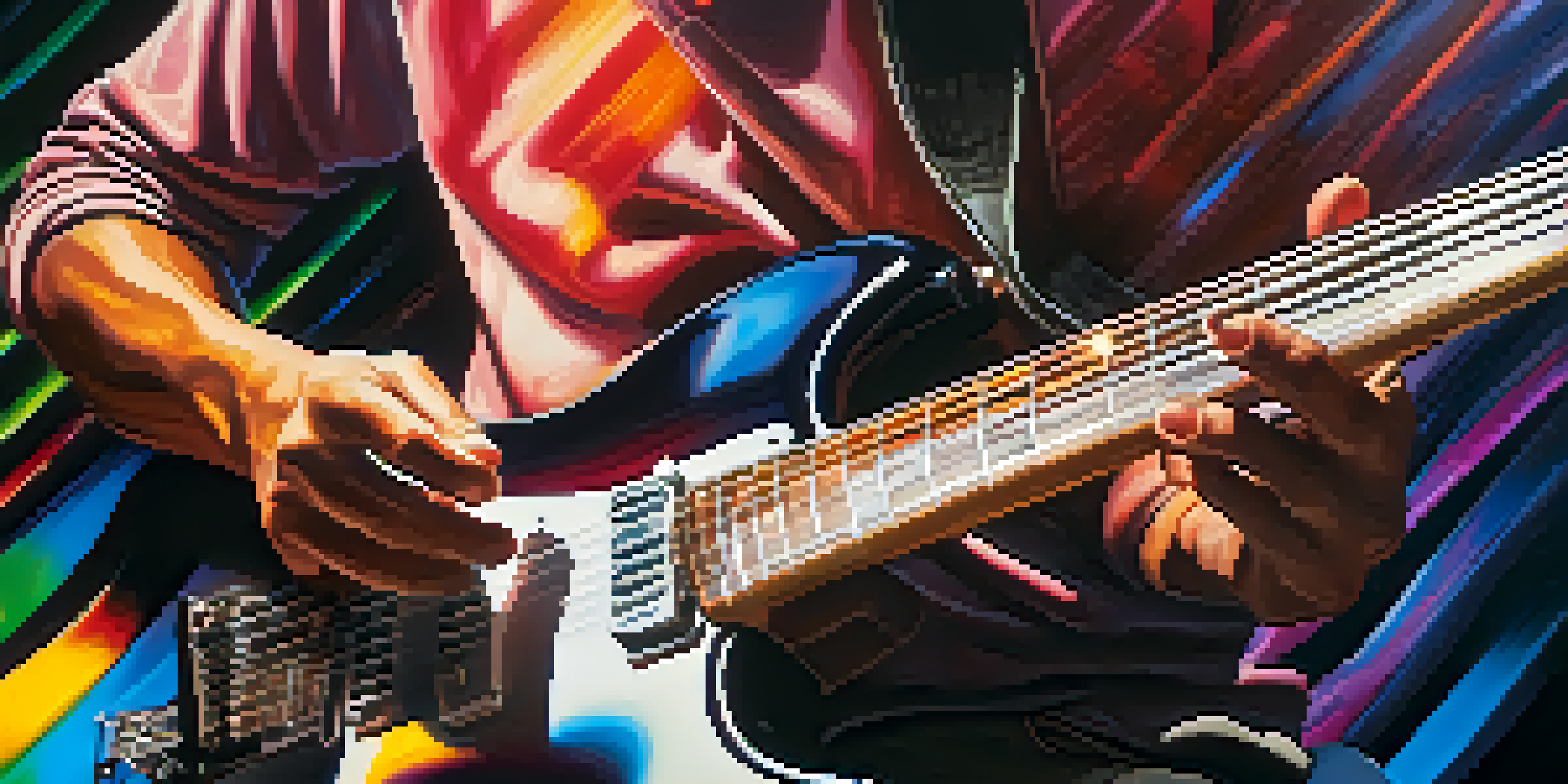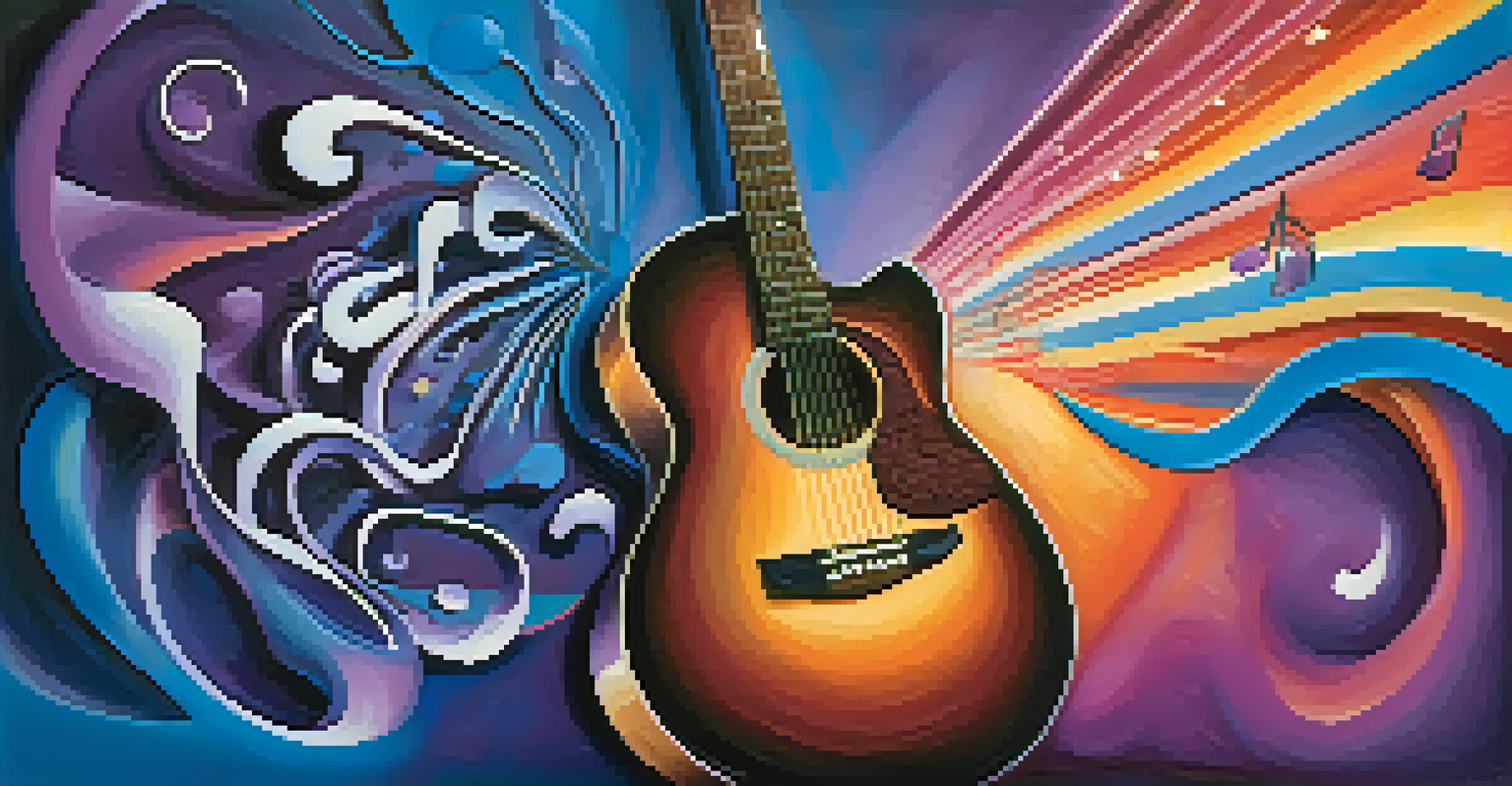The Art of Guitar Improvisation: Building Melodic Ideas

Understanding the Basics of Guitar Improvisation
Guitar improvisation is like painting with sound, where each note is a brushstroke. To get started, it’s important to understand the scales and chords that form the foundation of your music. Scales, such as the major and minor pentatonic, provide a roadmap, guiding your choices as you explore melodies. Think of it as having a palette of colors to choose from when creating your masterpiece.
Music is the shorthand of emotion.
Once you grasp the basic scales, you'll notice that they can evoke different emotions. For example, the major scale often sounds bright and happy, while the minor scale can have a more somber tone. This emotional connection is crucial in improvisation, as it allows you to express your feelings through your guitar. So, as you practice, pay attention to the mood each scale creates.
Improvisation is not just about playing the right notes; it’s about how you play them. Incorporating techniques like bending, sliding, and hammer-ons can add richness to your melodies. These techniques are like adding texture to a painting, making your improvisation more engaging and dynamic.
Developing Your Ear for Melodic Ideas
A crucial skill for any improviser is developing a keen ear for music. This means being able to recognize melodies and harmonies by ear, which can be nurtured through active listening. Try to listen to your favorite guitarists and mimic their phrases; this practice can significantly enhance your melodic vocabulary. Just like a chef tastes their dish while cooking, you should 'taste' the music before you play it.

Another effective way to develop your ear is through ear training exercises. Apps and online resources can help you identify intervals, chords, and melodies, sharpening your musical perception. It’s similar to learning a new language—repetition and practice make you fluent in the nuances of sound.
Mastering Scales for Improvisation
Understanding and practicing scales like major and minor pentatonic are essential for building a strong foundation in guitar improvisation.
As you improve your ear, you'll find that improvisation becomes more intuitive. You'll start to anticipate which notes will work well together, allowing your melodies to flow more naturally. Just like a conversation, the more you practice, the easier it becomes to express yourself.
Exploring Different Musical Styles
One of the joys of guitar improvisation is the variety of styles you can explore. Whether it's jazz, blues, rock, or classical, each genre offers unique techniques and approaches to improvisation. By delving into different styles, you can expand your musical palette, much like an artist experimenting with various mediums.
Improvisation is the ability to create something new, unique, and original in the moment.
For instance, jazz improvisation often emphasizes chord tones and complex harmonies, while blues relies on the expressive use of the pentatonic scale. Experimenting with these styles can help you find your own voice as a guitarist. Consider it as trying on different outfits until you find the one that fits you best.
Don’t hesitate to borrow techniques from various genres to create a unique sound. Mixing elements from blues with jazz improvisation can lead to unexpected and exciting results. This fusion can become your signature style, making your improvisations truly distinctive.
Creating Memorable Melodic Phrases
Crafting memorable melodic phrases is key to effective improvisation. Start by establishing a motif, a short musical idea that can be developed throughout your improvisation. This motif serves as a foundation upon which you can build variations, giving listeners something to latch onto. Think of it as a catchy hook in a song that makes it memorable.
Another technique to make your phrases stand out is to incorporate dynamics and articulation. Playing with volume, intensity, and the way you attack each note can add depth to your melodies. Just like a skilled actor uses their voice to convey emotion, you can use your guitar to express a range of feelings.
Developing Musical Ear Skills
Nurturing your ear through active listening and ear training exercises helps you recognize melodies and harmonies, enhancing your improvisational ability.
Don’t forget the importance of space in your improvisation. Silence can be just as powerful as sound, allowing your phrases to breathe and giving listeners time to absorb what they’ve heard. A well-placed pause can heighten anticipation and make your next note even more impactful.
The Role of Rhythm in Improvisation
Rhythm is the heartbeat of music, and its importance in improvisation cannot be overstated. A strong sense of rhythm can elevate your melodies, making them more engaging and lively. Practice playing along with a metronome or drum tracks to develop your timing and groove. Just like a dancer moving to the beat, your guitar playing should feel natural and fluid.
Experimenting with different rhythmic patterns can also add variety to your improvisations. Syncopation, for instance, involves placing emphasis on unexpected beats, creating a sense of surprise. This can make your melodies more captivating, much like a plot twist in a story that keeps listeners on the edge of their seats.
Ultimately, being aware of rhythm allows you to interact more dynamically with other musicians. Whether you’re jamming with friends or performing live, a solid rhythmic foundation helps you stay connected with the group. It’s like being part of a team where everyone is in sync, creating a harmonious musical experience.
Improvisation Techniques to Enhance Creativity
To take your improvisation to new heights, consider exploring various techniques to spark creativity. One such approach is to limit yourself to a specific scale or set of notes for a practice session. This constraint can push you to think outside the box and come up with fresh ideas, much like an artist working within a specific theme.
Another effective technique is to use call-and-response patterns. Play a phrase and then respond to it with another idea, creating a musical conversation. This back-and-forth can lead to spontaneous bursts of creativity, allowing your improvisations to evolve organically.
Experimenting with Styles and Techniques
Exploring different musical styles and incorporating various improvisation techniques can help you discover your unique voice as a guitarist.
Lastly, don’t shy away from experimenting with unconventional sounds or effects. Using techniques like tapping or harmonics can add a unique flavor to your improvisation. Just as a chef might use an unexpected ingredient to elevate a dish, these techniques can spice up your guitar playing and keep your audience intrigued.
Practicing Improvisation Effectively
Effective practice is essential for developing your improvisation skills. Set aside dedicated time to focus specifically on improvisation, using backing tracks or metronomes to create a supportive environment. This structured practice can help you refine your ideas and build confidence in your playing, similar to how athletes train for performance.
Recording your improvisations can also be a valuable tool for improvement. Listening back allows you to identify areas where you can enhance your phrasing or rhythm. It’s like reviewing a game tape; it helps you learn from your experiences and track your progress over time.

Lastly, don't forget to enjoy the journey of improvisation. Allow yourself to make mistakes and embrace the learning process. Just like any art form, the beauty of improvisation lies in its unpredictability, making every performance a unique experience.